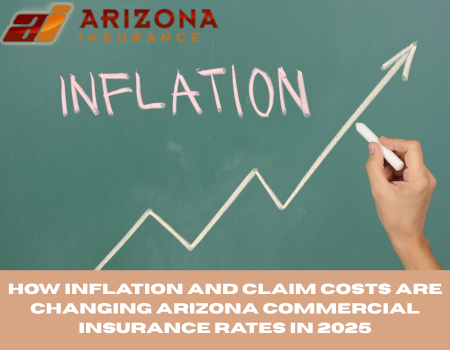For Arizona businesses, 2025 is shaping up to be a year when insurance costs are under renewed pressure. As policy-renewals come around, many companies are seeing harder questions, tighter underwriting, and rising premiums. Understanding what is driving these increases, and how to respond, can make a significant difference in budgeting, risk management, and long-term planning.
What’s driving the rate increases?
-
 Inflation of costs associated with losses
Inflation of costs associated with losses
High inflation across labor, materials, repair parts, medical bills and legal fees is forcing insurers to reassess how much they must charge to cover claims. Even when frequency of claims remains stable, the severity; the cost per claim, is rising. For example, a slip-and-fall or property damage claim that cost a few thousand dollars a few years ago may now run much higher. This “commercial insurance inflation” inevitably translates into higher premiums. - Rising claim severity and trends in litigation
In Arizona and nationwide, businesses face increasing exposure to larger jury verdicts, extended litigation, and complex claim types. The result: insurers are experiencing losses that erode profitability, which in turn causes carriers to increase rates or restrict capacity. One Arizona-specific source reports that liability insurance rates have been increasing significantly for many businesses. - Natural-hazard and catastrophe exposure in the Southwest
Though Arizona may not face hurricanes, the state does grapple with extreme weather (monsoons, wildfires, dust storms), and the Southwest region’s coverage market is already noting that natural hazard risk is driving cost and underwriting measures. Insurers increasingly factor in the risk of large-loss events when pricing commercial property and business-interruption coverage. - Hard market conditions and capacity constraints
According to a market forecast, commercial insurance rates remain under pressure because underwriting capacity is constrained, and insurers remain cautious about offering broad coverage at low margins. Even though some segments (especially property) appear to be moderating, many firms still face elevated costs. - Regional specifics for Arizona
In the surplus lines segment (higher-risk or hard-to-place risks), Arizona registered an 18.6 % increase in premium volume mid-2025 compared to the same period in 2024. While not all commercial policies fall in that segment, the data signals broad rate pressure. Moreover, general liability insurers in Arizona are citing inflation and changing risk dynamics as reasons for higher rates.
What this means for Arizona businesses
- Budget pressure: Businesses should expect higher renewal quotes, especially if they have modest claim histories, operate in higher-risk sectors, or own older buildings or equipment.
- Coverage may be tighter: Insurers may reduce limits, impose higher deductibles, exclude certain risks, or require more rigid underwriting standards.
- Risk management matters more than ever: Firms that can demonstrate strong loss-control, good property maintenance, and proactive safety programs may avoid the largest increases or negotiate better terms.
- It’s not uniform: While some lines may stabilize (for example, certain property lines are seeing more modest rate increases, according to national data), others, particularly liability and casualty lines, continue to climb. In Q1 2025, for example, U.S. casualty lines increased ~8 % while overall commercial rates actually declined 1 % in some sectors.
Practical steps for Arizona business owners
- Review your risk profile now
Prior to renewal, inspect property for deferred maintenance (roofs, electrical, HVAC), ensure safety protocols are up to date, and identify exposures such as wildfire risk or flood zones that may affect your property premium. - Shop smart and early
Start renewal discussions early. Compare multiple carriers, consider broking assistance, and highlight your risk-management efforts to gain leverage. Arizona businesses are particularly being advised to evaluate whether their current carrier is still competitive given shifting market conditions. - Consider higher deductibles or retention
If your risk appetite allows, raising deductibles can help reduce premium cost. But this only works if you have confidence in your loss-control systems and cash-flow to support a larger out-of-pocket cost in event of a claim. - Document your loss history and exposures
Insurers will look at your claim frequency and severity. Have clear documentation of prior claims, mitigation steps taken, and improvements made. Demonstrating that you are managing risks proactively can influence offered terms. - Be aware of inflation’s ripple effect
Remodels, repairs, replacement cost issues: if a loss occurs, the cost to rebuild or repair has likely increased due to inflation. Make sure your property values are up-to-date and that you don’t suffer under-insurance. - Explore alternative risk financing
For some larger Arizona businesses, alternatives such as captives, self-insurance layers, or parametric coverage may offer cost control where traditional markets are hardening. The broader market forecast cites this as an emerging trend.
The 2025 outlook for Arizona
While certain lines and geographies may see some moderation in inflation, the overall environment remains challenging. Candidate positive signs: some property coverage rates are seeing more modest increases than in the peak “hard market” years. Yet, for Arizona businesses, especially those with elevated risk profiles, the combination of inflation, large claims, natural-hazard exposure and limited underwriting capacity means that higher costs and tougher renewals are likely to persist in 2025. The key will be how individual businesses position themselves through loss mitigation, proactive maintenance, and smart policy design.
For Arizona businesses, understanding the forces driving commercial insurance costs matters as much as the premiums themselves. The convergence of inflation driven claim costs, evolving risk exposures and tighter insurance markets means that being proactive is critical. By assessing exposures, improving risk controls and engaging early with brokers and carriers, business owners can better navigate the 2025 insurance landscape. In short, this isn’t just about buying insurance, it’s about managing risk in a shifting market where inflation and claim costs are in play.
